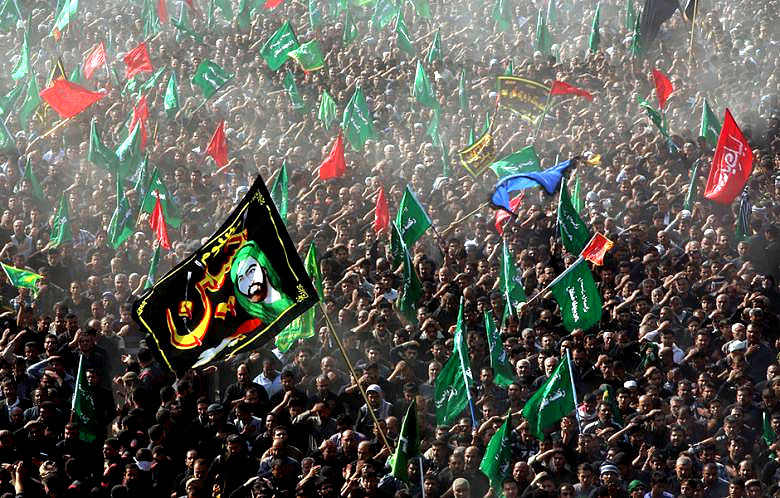 |
|
https://now.mmedia.me Karbala yesterday, Syria Tomorrow Ashura slogans instrumental for fighting in Syria “Here he is, al-Abbas is here,” yelled the host of the ceremony as Hezbollah chief Hassan Nasrallah made a rare public appearance in Sayyed al-Shuhada Complex in Dahyeh on Wednesday night. Thousands of men and women cheered their leader as he made his way to the podium on the eve of Ashura. “All hail the Abbas of our time,” the host continued, “for he has come to rescue you, oh Zeinab!” Nasrallah, who normally appears on screen via satellite for fear of assassination, spoke in Hezbollah's southern Beirut stronghold on the eve of the Shia Muslim Ashura holiday. He also appeared on the day of Ashura. Nasrallah’s public appearance is believed to be a message to the Shia community, which has been suffering blowbacks for the party’s fighting alongside the Syrian regime. “I expected it,” said a young woman dressed in black who refrained from mentioning her name. “Hezbollah’s fighting inside Syria is costing lives and putting ours [the Shia community’s] here [Lebanon] in danger.” The young woman, who further referenced the countless young men who have fallen in battle and the many civilians who were killed in the powerful car bomb that hit Dahyeh in mid-August, added, “He [Nasrallah] showed up to tell us that he too is ready to risk his life.” But apart from stating that “Iran and Syria are allies,” little was said – by Nasrallah or by any other Shiite politician or cleric – about the fighting inside Syria. Analyst Kassim Kassir tells NOW that ceremony speeches during the days of mourning featured ideas such as “the duty to fight takfiris” and the “importance of martyrdom” without directly referencing their relation to the recent battles taking place next door. Both Hezbollah and Amal, he continued, had circulated requests ahead of the event that their supporters refrain from talking about Syria and the ongoing fighting, which many now believe has taken a sectarian turn. It was noticeable that this year’s Ashura speeches avoided fueling tensions between Sunnis and Shiites over their opposing views on Syria. However, religious slogans and euphemisms, experts believe, were utilized strategically to mobilize for more fighting to come. Posters of faces of the young men killed so far sat alongside the many tributes to Zeinab and to al-Abbas. Zeinab is Imam al-Hussein’s sister who was taken captive following his death, and al-Abbas is Hussein’s half-brother who was given the authority to hold the standard in the battle. Flags, t-shirts, and vests also bore the message, “Na7nu Abbasik ya Zeinab,” Arabic for “we are your Abbas, oh Zeinab.” NOW speaks to Sheikh Mohamad Hussein al-Hajj, an independent Shia cleric, about the significance of these slogans. He explains that Ashura in itself is considered a school of thought for the Shia in general, which preaches about martyrdom, tyranny, oppression, and most importantly sacrifice. “We consider Ashura – the school of Imam al-Hussein – a lesson and a reference to follow and to replicate whenever a threat arises to any of Shiism, Islam, or to the Umma in general,” says Hajj. “Therefore in the event of a war or any form of conflict or confrontation – be it religious or political – our actions should be in line with the preaching.” Hajj believes that although there was no direct reference to the events in Syria, Ashura and its values were being used to intrinsically justify Hezbollah’s fighting there and to prepare for more to come. Lokman Slim, a Shiite social and political activist, agrees with the cleric and emphasizes that Hezbollah utilized Ashura this year “like a tool in a toolbox.” “The Ashura slogans this year were instrumental in identifying with what is happening inside Syria,” Slim tells NOW. “While al-Hussein is depicted as the icon of the martyr within the narrative of Karbala, al-Abbas is the fighter who kept on fighting to his last breath to salvage his community and family.” “We are all your Abbas, Zeinab,’” Slim added, “means to say that we [the Shia community] are all ready to fight to our last breath to protect Zeinab and what’s left of Zeinab – that is, her shrine in Damascus.” “Sometimes, by giving an example, one can get the message across better than having to reference it directly,” said the cleric, whose remarks fall in line with Slim’s. Creating the right mood and conditions, says Hajj, is enough to prepare the people and mobilize them without having to resort to sectarian rhetoric. “Now,” he stresses “the people are ready and the mass movement is in place for when the time comes to direct it in the way they see best.” Early on in the Syrian crisis, Hezbollah was trumpeting its presence in Syria and offering sacrifices under the pretext of protecting Shiite interests in the region, one of which is the shrine of Sayyeda Zeinab near Damascus. Today, as many commemorate Ashura, similar slogans are being promoted, such as “Lan tusba Zeinab marratayn,” Arabic for “Zeinab will not be held captive twice,” and “hayhat,” meaning “never again.” “It is an encapsulated reproduction of Hezbollah’s propaganda that is understood by any Shia,” says Slim “myself included, meaning that ‘never again will we allow the Sunnis to take control of us.’”
|
| top |